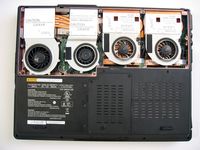SLI & Centrino 2: Gaming Laptops Battle
Killer Notebooks’ Odachi: Look and Feel
What the Odachi adds in pure muscle it gives up in polish compared to Alienware’s Area-51 m17x and even ASUS’ G71. Granted, Killer Notebooks is a smaller boutique outfit, which puts it at the whim of style choices made by whitebook ODMs like Clevo, Armia, and Compal. In this case, Clevo’s D9C is tapped as the shell of choice for Killer Notebooks’ Odachi.
In contrast to the all-black Area-51, the Odachi sports a two-tone grey/black chassis that, by its very nature, is more generic. The notebook’s lid takes an 18-mil laminated graphic shield, adding a more custom feel to the chassis. This is something we’ve become accustomed to from certain resellers thanks to Intel’s CBB (Custom Building Block) initiative.
The ports on either side of the notebook match up well to the chassis. Unlike the Alienware’s flush body, the Odachi cuts in on the right and left sides underneath the available jacks and connectors. Aesthetically, the m17x looks more attractive. However, the stair-step cut into the Odachi’s chassis does serve as a good place to grip the heavy notebook.
With the lid open, you can see that Clevo clearly wasn’t going for the same flush-mounted touchpad. It’s instead recessed and surrounded by a chrome bevel. The keyboard does have good tactile response, though. And because this is a large desktop replacement, there’s naturally enough room for a full-sized keyboard and 10-ley number pad.
Our only other concern is ventilation. The Odachi, loaded with its desktop processor, three hard drives, and two 8800M GTX graphics cards, generates copious heat, which is exhausted from the chassis through four blowers. The quartet pulls air from vents on the bottom of the notebook. Although we didn’t have any heat problems on our test bench, it’d be conceivably pretty easy to block those vents and end up with insufficient cooling. At the very least, this probably isn’t a notebook you’ll want to use on your lap.
More Go-Fast Potential
The folks at Killer Notebooks obviously know they’re at a manufacturing disadvantage when it comes to the other former-boutique shops that have sold to larger vendors, such as Alienware and VoodooPC. To help bridge that gap between brains and beauty, Killer makes an extra effort to tune its notebooks for performance. In fact, the company originally sent its sample running a 64-bit copy of Vista Ultimate with several hours worth of tweaks applied, including optimizations for each installed application that’d milk the most performance from the quad-core CPU.
Get Tom's Hardware's best news and in-depth reviews, straight to your inbox.
We formatted the machine to normalize on a 32-bit environment, but it’s still worth noting that our benchmark scores would have likely been higher had Killer Notebooks re-tuned the Odachi as it would have for a customer. In fact, the company says that if a customer sends his or her software to Killer Notebooks as his or her machine is being built, it’ll install and tweak the software to best utilize the hardware. Why didn’t we send the system back for another round of tweaks on our benchmark suite? As you’ll see, the performance results are already fairly compelling.
There’s also another option emerging. Killer Notebooks plans to make its Core Optimization Program (COP) available to customers, enabling do-it-yourself per-application optimizations. Killer says each app takes about 20 seconds to set up and gives the enthusiast complete control over where each thread runs. In this way, you’re able to dictate that a virus scan runs on Core 4 while Crysis employs Core 1, for example.
Current page: Killer Notebooks’ Odachi: Look and Feel
Prev Page Killer Notebooks’ 17.1” Odachi: Hardware Next Page Eurocom M860TU 15.4” Montebello: Hardware-
kitsilencer From a money point of view, it's never going to make sense buying a gaming laptop. Scaled down performance and inability to upgrade are issues.Reply
But it sure as hell feels good having one ^___^ -
neiroatopelcc http://www.tomshardware.com/reviews/gaming-notebook-roundup,2023-6.htmlReply
"shipped the system with a 64-bit copy of Vista Ultimate (Alienware included x32 Home Premium)." -
ap90033 4 Grand? Are you guys nuts? I would say that right there would rule out about 90% of us normal gmaers..Reply
Besides the gaming scores looked weak imo..
I personally thought it was a better idea to go get a Gateway P7811FX with a single Geforce 9800GTS. It plays Call of Duty at 1920x1200 max settings around 50FPS. AND it cost me ONLY $1249 (Plus Best Buy let me pick any game I wanted for FREE!) -
agree with kitsilencer, gaming laptop is never practical.Reply
even with a beast graphics card, you'd be pretty hard to get more than 2 hours of shitty performance.
get a gaming desktop and perhaps an EEE or iPhone for travelling. my iPhone has 20+ games and enough media (don't forget TV connector for watching films in hotels) to keep me busy for more than one week away from my gaming rig. -
ap90033 Not true my "Gmaing Laptop" is great at LAN Parties and I play it for 6-8 Hours straight there...Reply
I think maybe you had a bad experience with a laptop that claimed to be a "gaming" laptop. I bought one before like that and it have an 8600M Geforce and it Sucked bad... If you get a good laptop with say a 9800gts or so you would be suprised... -
GlItCh017 ap900334 Grand? Are you guys nuts? I would say that right there would rule out about 90% of us normal gmaers..99.90%Reply -
ap90033 PS gaming laptops hold value much better than desktops. I had one I paid 1250 for, had it for a year, then sold it for $1100 and bought the newer "upgraded" model that just came out for $1250. I got an Upgraded CPU (From Core 2 1.67 GHZ to Core 2 Centrino 2 2.26 GHZ), Memory (from 3 Gigs DDR2 667MHZ to 4 Gigs DDR3 1066MHZ), Hard Drive (faster), Video Card (from 8800gts to 9800GTS), Screen (from 1440x800 to 1920x1200) and OS (From 32 bit to 64 bit). Not bad upgrade for $150 or so!Reply



